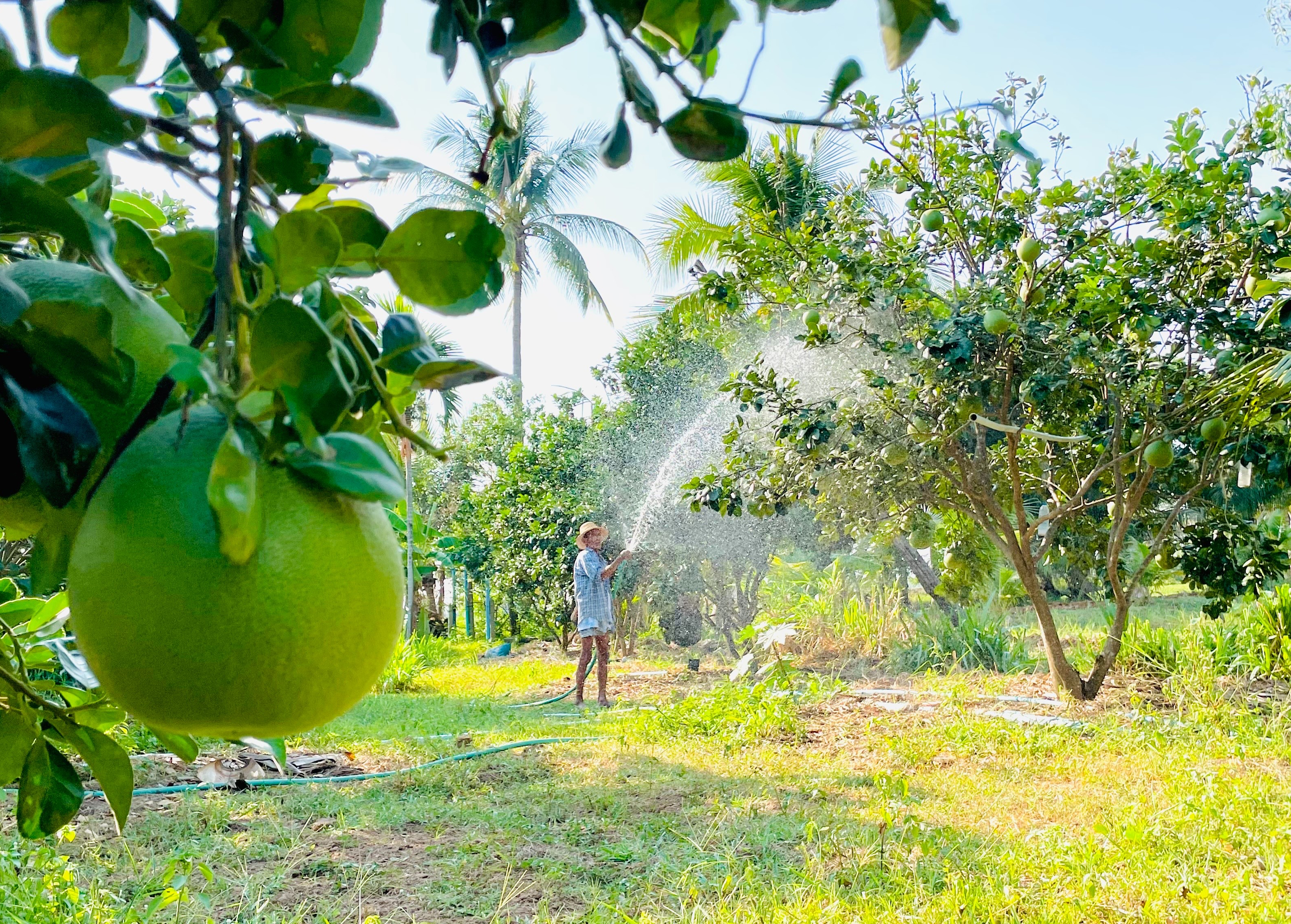Developing Integrated Pest Management for Pomelo Farmers in Baan Paengpuay Community, Buriram Province, Thailand
Main Article Content
Abstract
Pomelo farmers in Ban Paengpuay, Nangrong District, Buriram Province, Thailand faced challenges due to pest outbreaks, leading to reduced pomelo quality and financial losses. This study aimed to enhance the pest management skills of pomelo farmers and assess the resulting impact. Thirty farmers were selected to participate in the project, which unfolded through the processes of community information gathering, implementation of integrated pest management, and knowledge exchange. Initial steps involved gathering insights from the community to plan project operations. This included collecting community data, organizing forums for diverse perspectives, and devising plans for knowledge transfer. Agricultural extension services helped diagnose plant diseases and pests, identify nutrient deficiencies, and introduce integrated pest management techniques for pomelo cultivation. The second phase focused on implementing pest management techniques tailored to pomelo plots. Methods included mechanical pest control, moth traps with molasses, sticky glue traps, fruit wrapping, and biological pest management using Bacillus subtilis, Bacillus thuringiensis, and Trichoderma Metarhizium. In the third phase, the project facilitated knowledge exchange among participants. Results showed significant improvements, with pomelo production increasing by 85.21 percent. Chemical usage decreased, resulting in savings of 1,200 to 1,400 Baht per Rai (approximately 234.38-273.44 USD per hectare). Production costs decreased by 2.46 to 2.67 percent, and compliance with Good Agricultural Practices (GAP) standards increased by 30 percent, with 11 farmers obtaining certification. Furthermore, pomelo farmers showed a significant increase in knowledge, with a 124.04 percent improvement. This led to better problem analysis skills and increased capacity for exchanging insights. Participants also demonstrated higher confidence and commitment to self-improvement and the advancement of pomelo production practices.
Article Details

This work is licensed under a Creative Commons Attribution-NonCommercial-NoDerivatives 4.0 International License.
Area Based Development Research Journal values copyright protection and licensing to safeguard author rights and facilitate the appropriate dissemination of research. Our policies ensure openness, accessibility, and attribution. Authors retain copyright ownership, and articles are published under a Creative Commons Attribution License (CC BY), allowing sharing, adaptation, and proper attribution. Authors have the freedom to publish under the CC BY license, granting broad reuse and distribution permissions. The journal supports posting articles on third-party repositories, adhering to institutional and funding restrictions. Author guidelines detail copyright and licensing requirements, empowering authors with knowledge about their rights and responsibilities. These policies cultivate an environment of collaboration, openness, and responsible sharing, benefiting authors and the research community while honoring intellectual property rights.
References
Bashir, M. A., Alvil, A. M., & Naz, H. (2014). Effectiveness of sticky traps in monitoring insects. Journal of Environmental and Agricultural Sciences, 1(5), 1-2.
Buakaew, P., & Panpakdee, C. (2024). Socio-economic factors influencing good agricultural practices of herbal farmers in Buriram province. Journal of Agriculture, 40(1), 101-111. (in Thai).
Chamswarng, J. (2017). Trichoderma is a fungus that affects crop production in the future. Kasetapirom Journal, 4(19), 14-17. (in Thai).
Damrongrak, I. (2007). Plant nutrient elements and fruit quality of Shokun mandarin (Citrus reticulata Blanco cv. Shokun). Journal of Yala Rajabhat University, 2(1), 56-71. (in Thai).
Department of Agricultural Extension. (2012). Biological pests control. (1st edition). Bangkok: Bureau of Technology Transfer Development.
Department of Agricultural Extension. (2020). Utilizing microorganisms (microbial pesticide) to manage pests. (2nd edition). Bangkok: Bureau of Technology Transfer Development.
Department of Agricultural Extension. (2022). Field pest diagnosis. Retrieved October 3, 2022, from: https://k-station.doae.go.th/?s=วิินิิจฉััย. (in Thai).
Food and Agriculture Organization of the United Nations. (2017). Integrated pest management of major pests and diseases in Eastern Europe and the Caucasus. (1st edition). Budapest, Hungary: FAO.
Food and Agriculture Organization of the United Nations. (2020). Integrated pest management of major pests and diseases of grapevine, pepper and tomato in North Macedonia. (1st edition). Budapest, Hungary: FAO.
Food and Agriculture Organization of the United Nations, & University of Bonn. (2021). Climate change impacts on 20 major crop pests in Central Asia, the Caucasus and Southeastern Europe. (1st edition). Ankara, Turkey: FAO.
Holmes, L., & Mandjiny, S. (2016). Biological control of agriculture insect pests. European Scientific Journal, 12(10), 216-225.
Issarakraisila, M., & Intana, W. (2011). Studies on types of bagging materials affected on growth, quality and disease-insect damages in pummelo fruit cv. Tongdee and Tubtim Sayam. (Research report). Bangkok: National Research Council of Thailand. (in Thai)
Jamonman, S., Jongrattanameteekul, W., Sonthirat, S., & Suwannakul, D. (2000). Pests management. Bangkok: Ruaw Khiao.
Namburee, S. (2019). Participation theory in public administration. The Journal of Research and Academics, Mahachulalongkorn-rajavidyalaya University, 2(1), 183-197. (in Thai).
Natongkham, A., Sirimungkararat,S., Saksirirat,W., Urairong, H., & Kaewrat, B. (2010). The efficiency of northeastern isolates of green muscardine fungi metarhizium spp. on controlling economic insect pests. KKU Research Journal, Khon Kaen University, 15(10), 930-940. (in Thai).
Office of Agricultural Research and Development Region. (2021). Utilizing bacillus subtilis for crop production. Retrieved September 8, 2022, from: https://www.opsmoac.go.th/chumphon-dwl-files-432791791819. (in Thai).
Osotspa, Y. (2016). Plant stress and stress relieves. Thai Journal of Soils and Fertilizers, 38(1), 47-78. (in Thai).
Phawasut, A., Chaemkerd, P., Sakpreechakul, T., Uttama, K., Kamol, N., & Chansawee, N. (2020). Research and development of safety citrus production. Retrieved August 30, 2022, from: https://research.hrdi.or.th/research/detail/432/. (in Thai).
Plant Protection Research and Development Office. (2012). Pomelo pests management for exports. Retrieved October 25, 2022, from: https://www.doa.go.th/plprotect/wp-content/uploads/Km/grapefruit.pdf. (in Thai).
Prachachatturakit. (2022). After 15 years of waiting, the United States now permits unlimited importation of Thai pomelo. Retrieved September 23, 2022, from:https://www.prachachat.net/economy/news-856744. (in Thai).
Sonthirat, S. (2015). Pest control vs pest management. Kasetapirom Journal, 1(5), 41-43. (in Thai).
Taylor, P. (2015). Plantwise diagnostic field guide. (1st edition). London, United Kingdom: CABI on behalf of Plantwise.


